Under Matthew Benham’s ownership, Brentford Football Club has become synonymous with innovation.
The Bees have adopted a model that emphasizes and values complex statistical data, thereby trying to identify undervalued players whose financial situation aligns with theirs in the seemingly unsustainable cauldron of the EFL Championship.
Nonetheless, Brentford´s recruitment strategy – the envy of many EFL clubs – has allowed them to remain competitive without risking a financial catastrophe or Financial Fair Play complications.
Benham opted to be more aggressive in the summer transfer window, given that the 2019/20 season will be the last at Griffin Park.
Bryan Mbeumo arrived for a somewhat hefty £5.65m from Ligue 2 side Troyes to play a starring role on the right wing.
Mathias Jensen added additional midfield creativity.
Halil Dervişoğlu (available from January) and Joel Valencia were bought from Sparta Rotterdam and Piast Gliwice in Poland, respectively.
This outlay has been rewarded - before football was suspended, the West London side was fourth, in a stable play-off position, and dreaming of Premier League promotion.
This tactical analysis will specifically examine Thomas Frank's offensive tactics and how Brentford´s style of play elevated them to joint-top scorers in the EFL Championship.
Thomas Frank Formations
I would be remiss to delve into the nuances of Brentford’s attacking principles without initially outlining their team profile.
4-3-3 has developed into the go-to formation for many coaches in the modern-day.
Although formations are not binary and rigid, the 4-3-3 lends itself to the creation of triangles that are helpful in the build-up play.
Frank’s style of play is particularly possession-based, which is likely a contributing factor to his choice of such a formation.
It is worth noting that a 3-4-3 formation was more common in the early stages of the season.
However, only two wins were garnered in the nine games where this system was used (a 22.2 win %), whereas, since the switch to a 4-3-3 formation, 15 games have been won (a 53.8 win %).
Brentford FC Formation & Starting XI
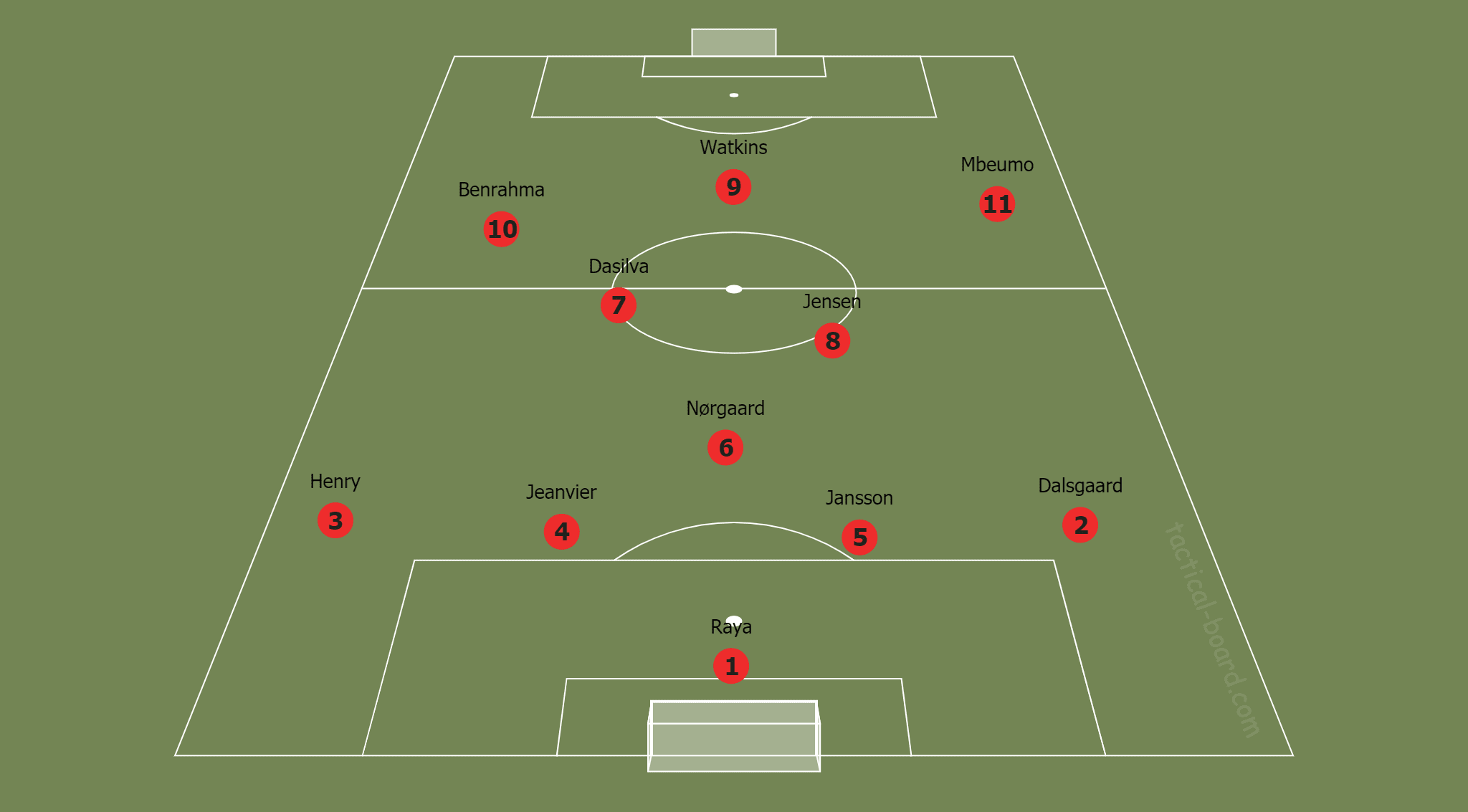
Above is a graphic that portrays arguably Thomas Frank’s preferred starting XI at Brentford this season.
Brentford Key Attacking Players
The intuitively nicknamed ‘BMW’ front three of Saïd Benrahma, Ollie Watkins and Bryan Mbeumo have significantly contributed to the offensive workload.
After 37 game-rounds, the Bees attacking trio have 62 goal contributions between them (goals + assists).
In terms of goals, the trio has 46 goals combined, which makes up 71.9% of Brentford’s total goals scored (64), demonstrating their importance on the Bees’ attacking play.
Benrahma, in particular, has already been linked with a transfer to Arsenal.
Brentford FC Build-up Play
Unlike other analysis pieces, this is based entirely upon Brentford’s tactics in possession—when they have an offensive mindset and are looking to score.
The Bees have a methodical, patient approach to the build-up phase.
There isn’t an extremely heavy emphasis on verticality, potentially because his forwards lack the necessary physicality to hold off defenders for third-man passes.
Instead, primarily involving the two centre-backs and lone pivot Christian Nørgaard, Frank wants ball progression that is effective but also controlled.
The Danish coach wishes for his team to be the protagonists, dictating the tempo of a match.
This is reflected by Brentford having the third-highest average possession in the league, with 56.8%.
Christian Nørgaard: Pivotal For Build-up Play
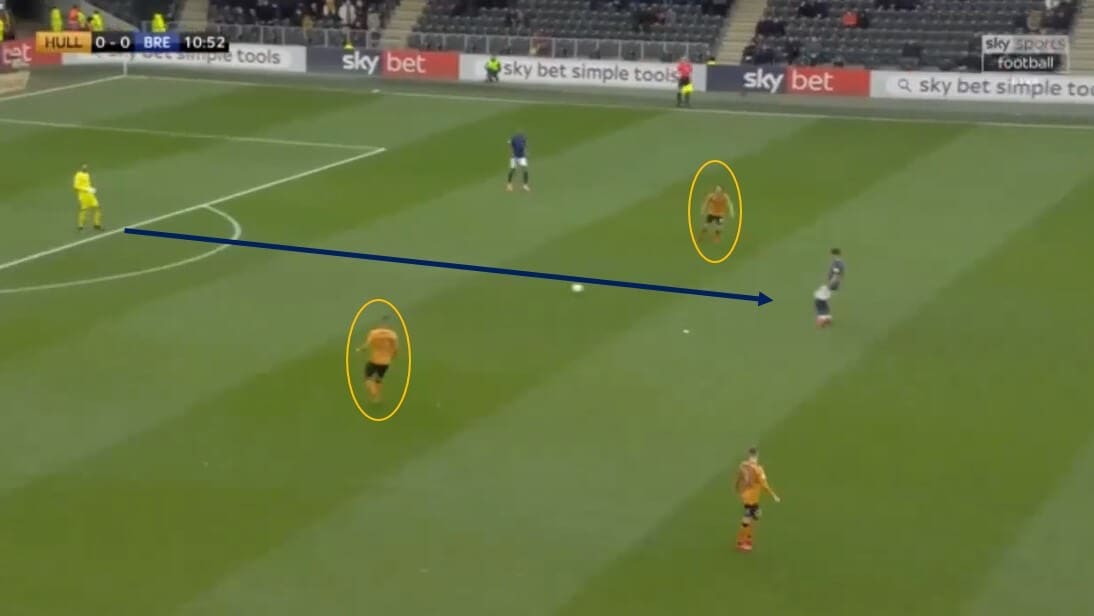
Whilst Nørgaard does not drop into the defensive line, he does have an influential role in ensuring turnovers do not occur in dangerous areas, as well as providing or shuffling laterally to create passing lanes.
In the example above we see the 26-year-old midfielder positioning himself perfectly to receive off keeper David Raya and split Hull’s first-line.
Centre-backs: The Build-up Play Launchers
Thomas Frank gives his centre-backs the impetus to launch Brentford's build-up play.
When fully fit, the most common pairing is Pontus Jansson and Ethan Pinnock, both summer signings.
Jansson came from Marcelo Bielsa’s Leeds, while Pinnock came from Daniel Stendel’s Barnsley—coaches with a possession-based philosophy.
Both centre-backs possess adequate technical quality to make incisive passes to more attacking players in the half-spaces or between the lines.
Furthermore, I also see it necessary to mention that Jansson is right-footed, whereas Pinnock prefers his left foot.
Having the luxury of this means better angles can be formed with greater pass accuracy.
A right-footer playing on the left can be prone to coming back inside, thus not utilising the basic principle of width in the attacking phase.
Brentford FC Build-up Play Patterns
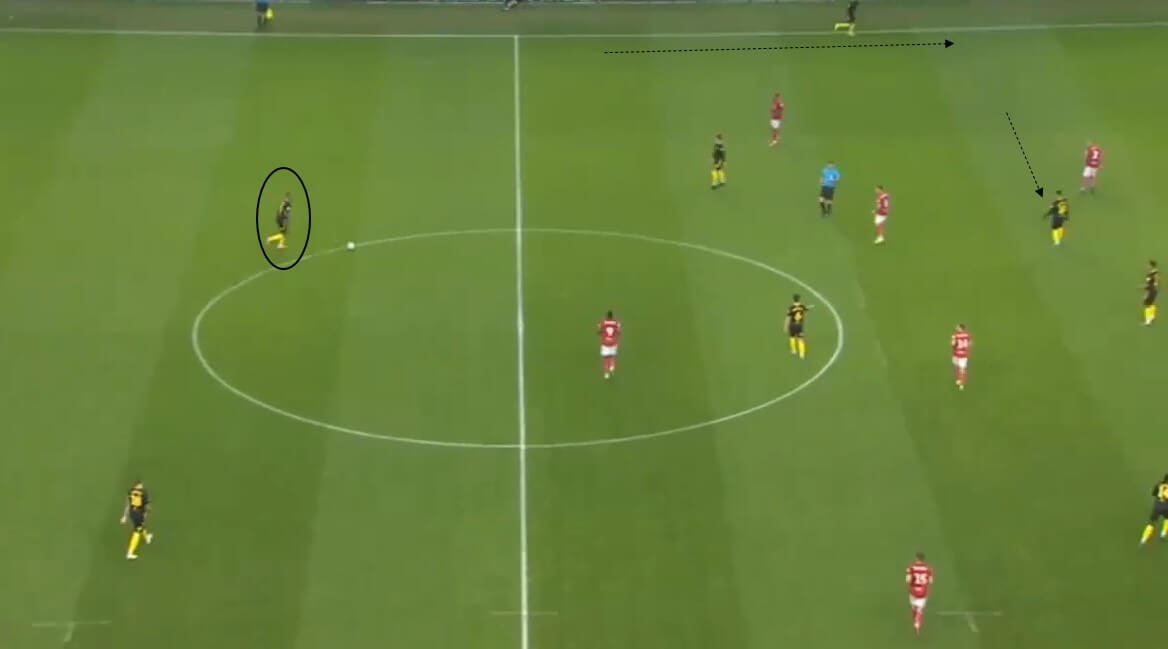
In the example above, we can see the general spacing of Brentford’s build-up play.
In this scenario, Benrahma has drifted into the half-space with left-back Rico Henry advancing into the vacated wide channel.
In line with Frank’s philosophy, Pinnock has space to receive and switches the play to Mbeumo on the right, who is off-screen.
While the full-backs are naturally attack-minded, they are positioned not too aggressively but rather on a similar line to Nørgaard.
There is a fine balance between wanting to play on the front foot and offering progressive passes without leaving their defensive partners overly exposed.
It is essential to note the full-backs’ deeper positioning subsequently gives Mbeumo and left-winger Saïd Benrahma more space to operate.
If they don’t push up to a great extent, the opposition winger may be attracted to them instead of either winger, who are arguably Brentford’s most threatening players.
Below, we can see Henry’s relatively deep location during the build-up phase.
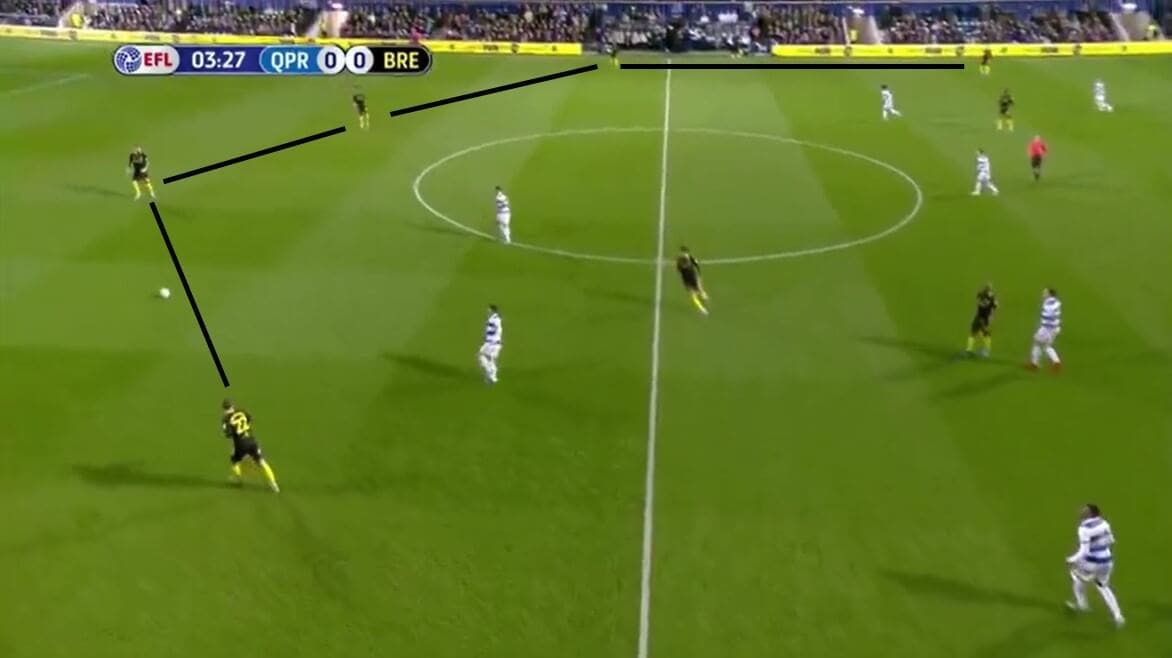
An additional plus of the 4-3-3 compared to the 3-4-3 is the extra man in the midfield.
This can be helpful when play is congested on the touchline, where another possible passing lane can now be into the centre.
In truth, their mere presence is a positive as it is a further dilemma for the opposition to acknowledge and defend against.
In the scenario below, Josh Dasilva is situated in the half-space, meaning the English midfielder somewhat occupies QPR midfielder Geoff Cameron.
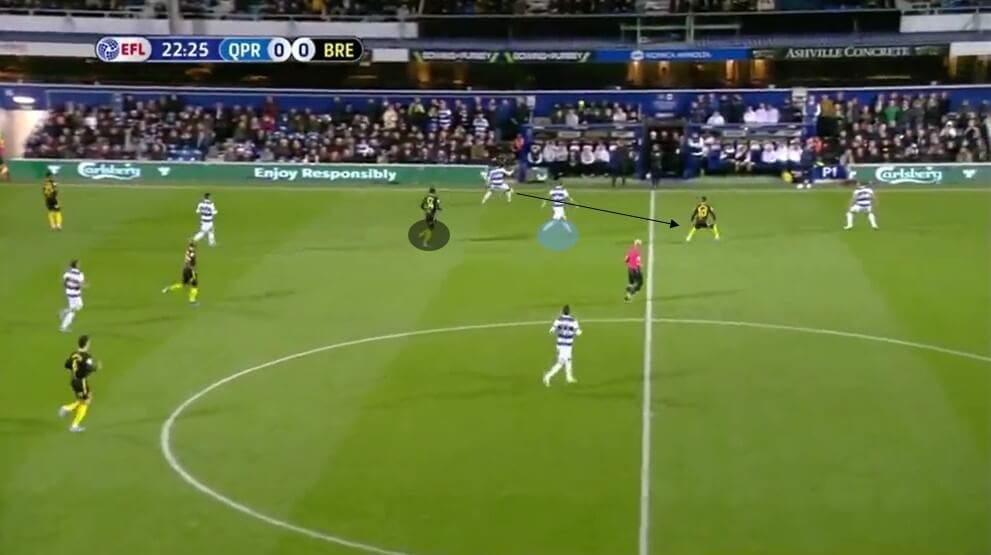
However, Benrahma has dropped off on Cameron’s blindside, allowing him to receive off left-back Henry.
This movement of Dasilva generated issues for Cameron, who was left with both Dasilva and Benrahma to mark.
Why 4-3-3 Instead Of 3-4-3 Formation?
There is an argument to be made that the 3-4-3 formation saw Brentford’s build-up become unduly predictable.
Only having two midfielders, one of whom is usually Nørgaard, who is more focused on being a circulator than an actual offensive threat like Dasilva, can contribute to their attacks being too wing-orientated.
In contrast, I believe the 4-3-3 formation allows Frank to include more creative players while being better balanced.
Mbeumo & Benrahma : Chance Creation Stars
When you evaluate Brentford’s squad, two players stand out: the first-choice wingers Benrahma and Mbeumo.
Both signed from France, their technical quality is conceivably already at the Premier League level, which is demonstrated in their output this season.
Benrahma has 10 goals and has 7 assists
Mbeumo scored 14 goals and has 7 assists.
Therefore, because these are Frank’s most valuable offensive assets, it is logical to maximise their space and involvement in chance creation moves to exploit their dribbling qualities.
Especially with Mbeumo Brentford trying to get positional superiority to isolate the winger 1v1 with the opposition full-back.
Qualitative superiority can also be prevalent, but this is more difficult to identify as it’s inherently subjective.
Furthermore, the pair play on the opposite side of their strongest foot.
This means that they tend to cut inside centrally.
If they had been initially isolated with the full-back, then by doing this action, they would, in theory, be dribbling back towards the shifting defence, which is seeking to restore balance and compactness to their shape.
I will now look at some illustrated examples of this.
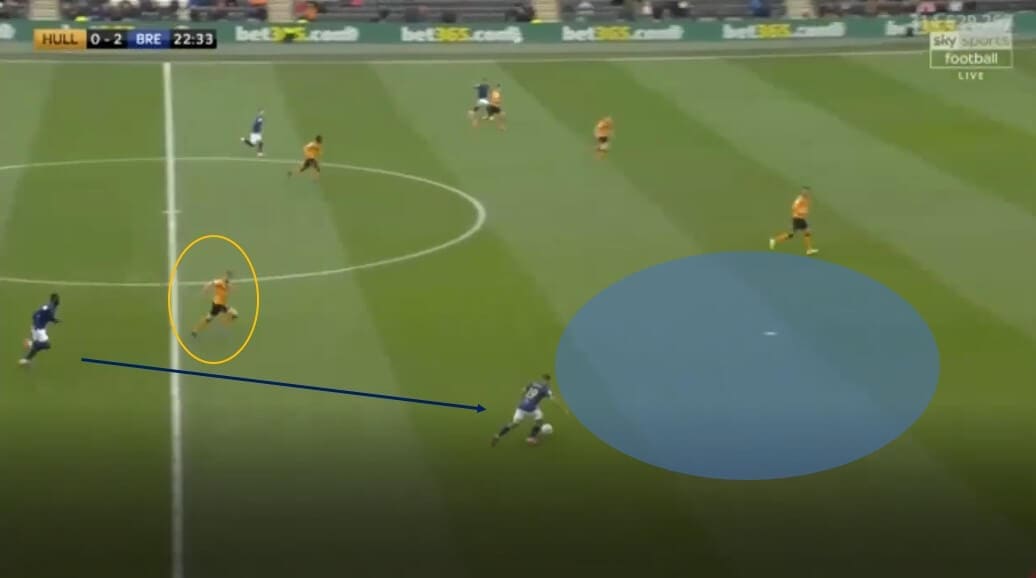
This is a demonstration of how encouraging opposition defenders to engage can release space elsewhere for more skilled players, such as Mbeumo and Benrahma, to exploit.
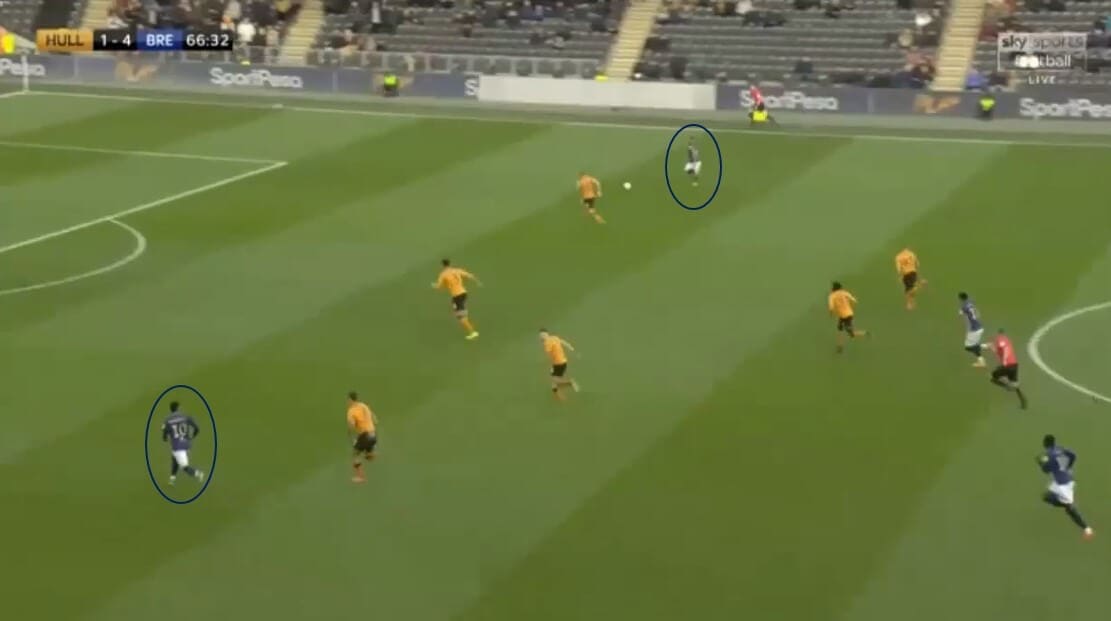
In the image above, this movement creates more space for the winger by pulling wide and, thus, more time to attack directly.
Moreover, this action has generated a dilemma for the defence: press the winger close to the touchline and reduce his time, but vacate space centrally for midfield runners to exploit.
It is a simple tactic, but combined with attack-minded central midfielders like Dasilva and Jensen, it can be effective in creating problems for opponents—this premise is comparable to what Pep Guardiola uses at Manchester City.
Speed is also a facet of the wingers’ game.
This is why getting in-behind can be a beneficial attacking mechanism.
Doing this puts the opponents on the back-foot and forces them to backtrack.
Such a method helps Brentford to make the best use of their offensive players’ skillset.
For example, the wingers can take advantage of their positional superiority, while midfield runners and the other forwards can advance, making supporting runs into and around the box for potential crosses and cut-backs.
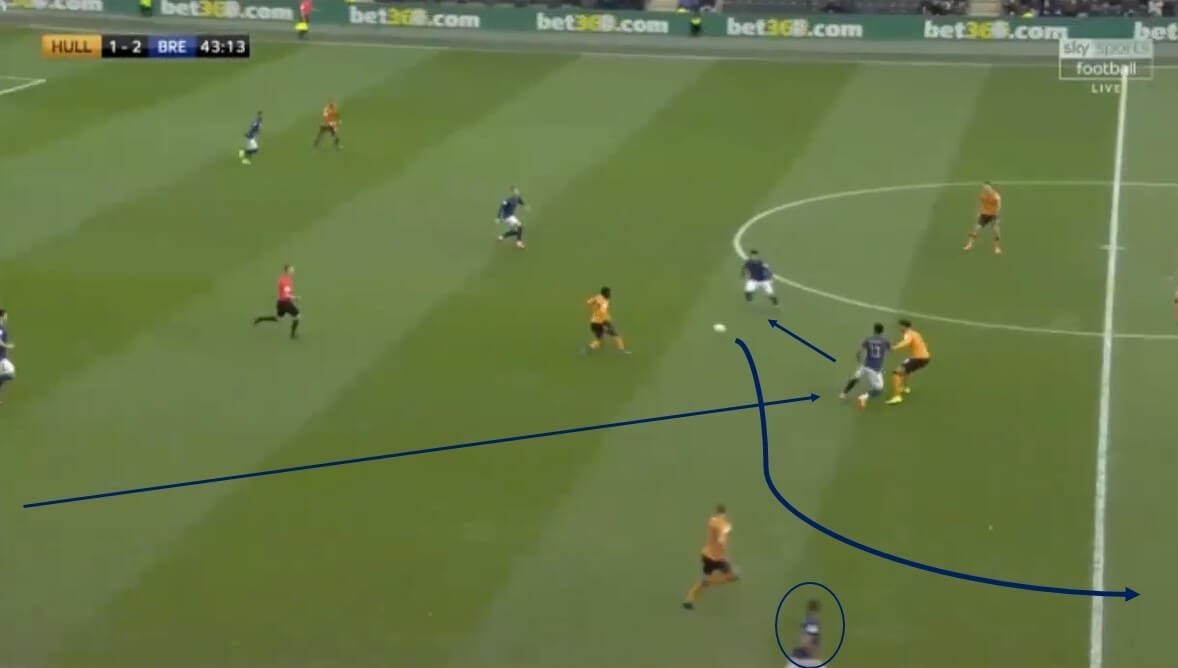
A similar scenario arises below, eventually leading to a goal.
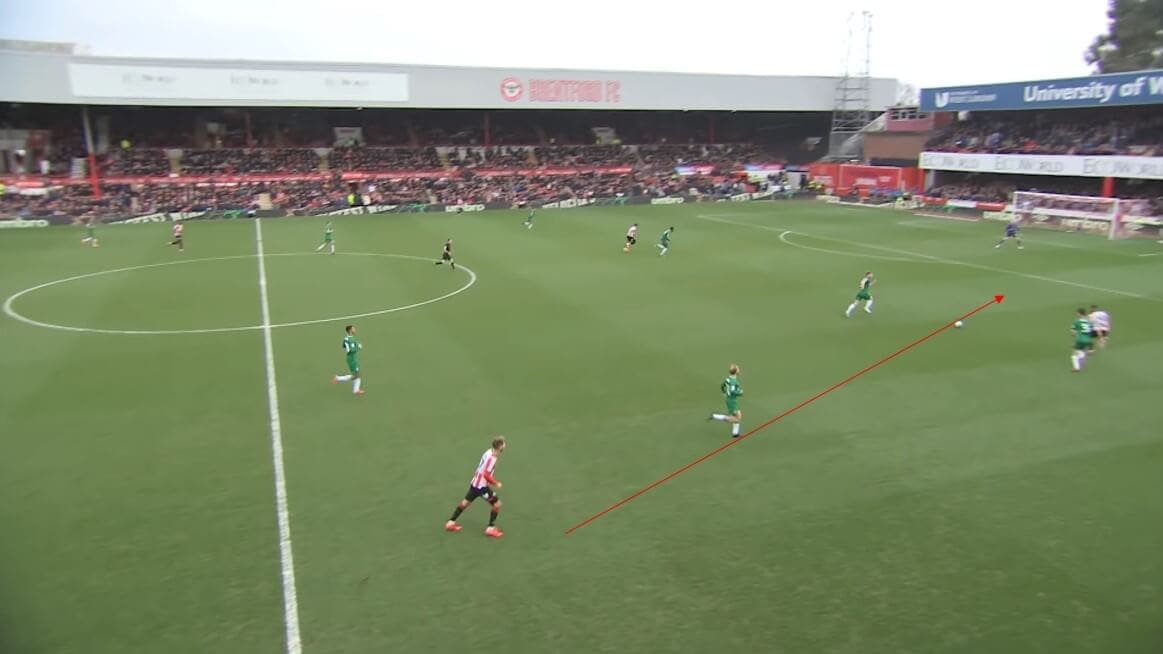
Brentford FC Set-pieces
I referred earlier to Brentford’s reputation as innovative thinkers, whereby they are constantly seeking marginal gains.
Set-pieces are a tool that, if used appropriately, can provide a competitive advantage over teams that are still basic in their thinking.
As per their strategy and club identity, Brentford employs a coach whose single focus is on set-pieces.
Looking at the statistics, the results of this investment are relatively good.
The Bees scored 12 goals from set-pieces this season, above the EFL Championship average of 10.1.
These 12 goals represent 19% of all their total goals scored.
Brentford FC Corner-kick Routines
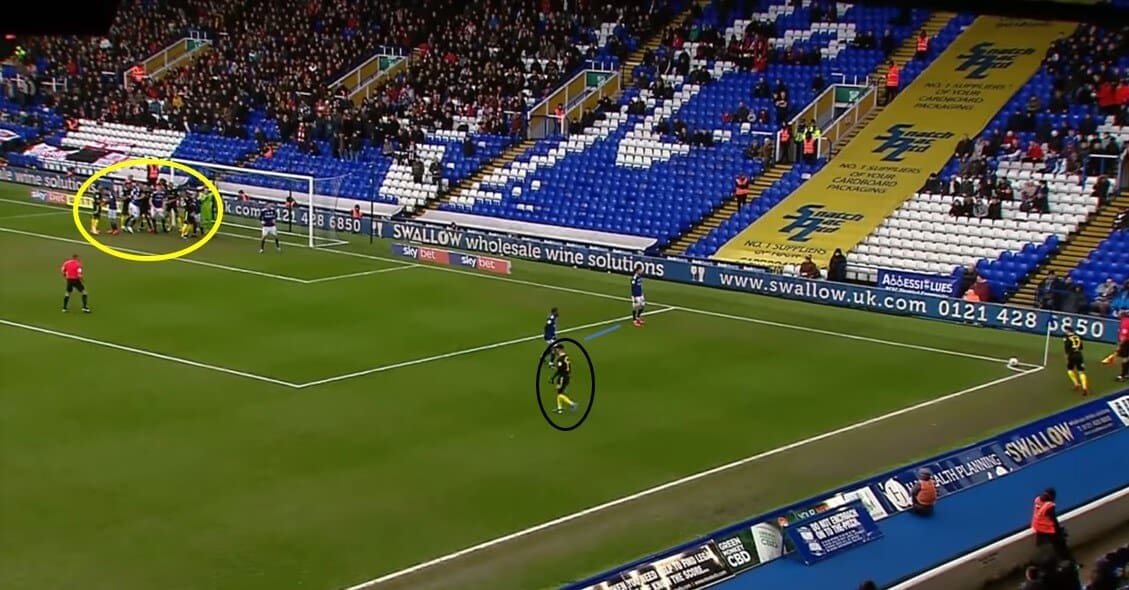
The first example against Birmingham above portrays an effective use of blockers to create space for an aerially dominant player.
Brentford completely overloads the far post with five of its most physically dominant players, then impinges on the goalkeeper.
Benrahma has come short, so he is dragging two Birmingham players with him in case of a short corner routine, emptying the box some more.
The corner-taker Marcondes flatly drills the ball to the back post, where the 6’ 1” Pinnock has peeled off.
However, because his teammates act as blockers, he is free and scores, as seen below.
A similar routine is apparent versus Swansea below.
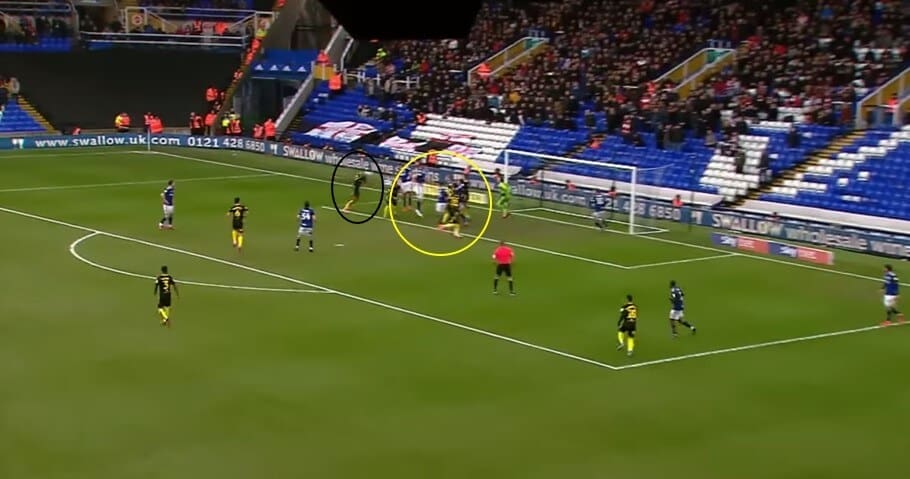
Once more, Benrahma has offered the option to play it short, although only one Swansea player has been drawn out this time.
Elsewhere, five Brentford have packed out the GK and far-post zone.
This extreme occupation of the far-post zone naturally attracts Swansea markers, resulting in an underload of the near-post area.
The delivery isn’t as accurate, though; therefore, Pinnock is deeper when receiving and isn’t able to go directly for the goal.
However, the former Barnsley man heads back across to Mbeumo, who can nod in from the near-post zone.
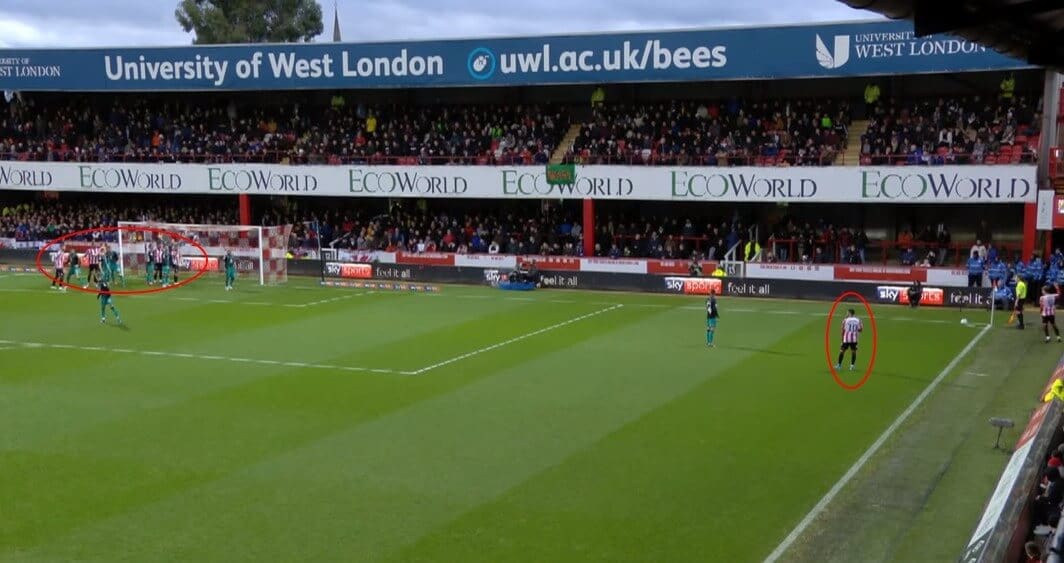
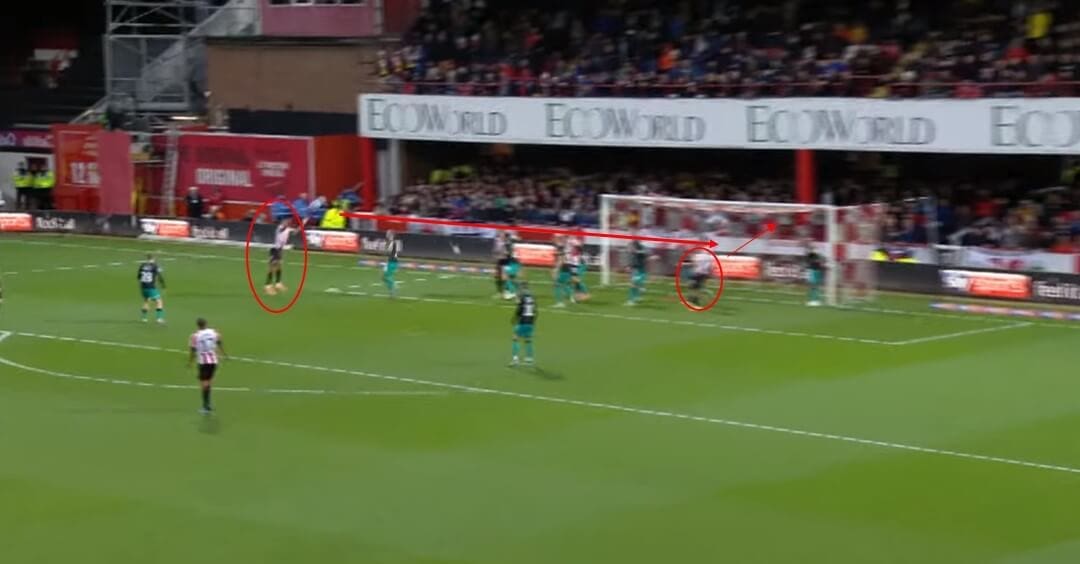
It is also worth highlighting the presence of Brentford players on the edge of the box in those two examples.
They can either help sustain attacks or occupy defensive players, allowing for greater space in and around the six-yard box.
Brentford FC Corner-kick Variation
The following Brentford corner-kick routine differs from the preceding ones as it is against a zonal-marking set-up in West Brom.
Below, the hallmark of Benrahma’s positioning nearby is still visible, but no intense overload is present in any zone.
What is clear, though, is there is a large amount of space available in the near-post region.
The subsequent frame illustrates the situational aspects better.
It seems there has been a conscious effort not to stand in this region; a number of the taller Brentford players are spaced out and in deeper positions.
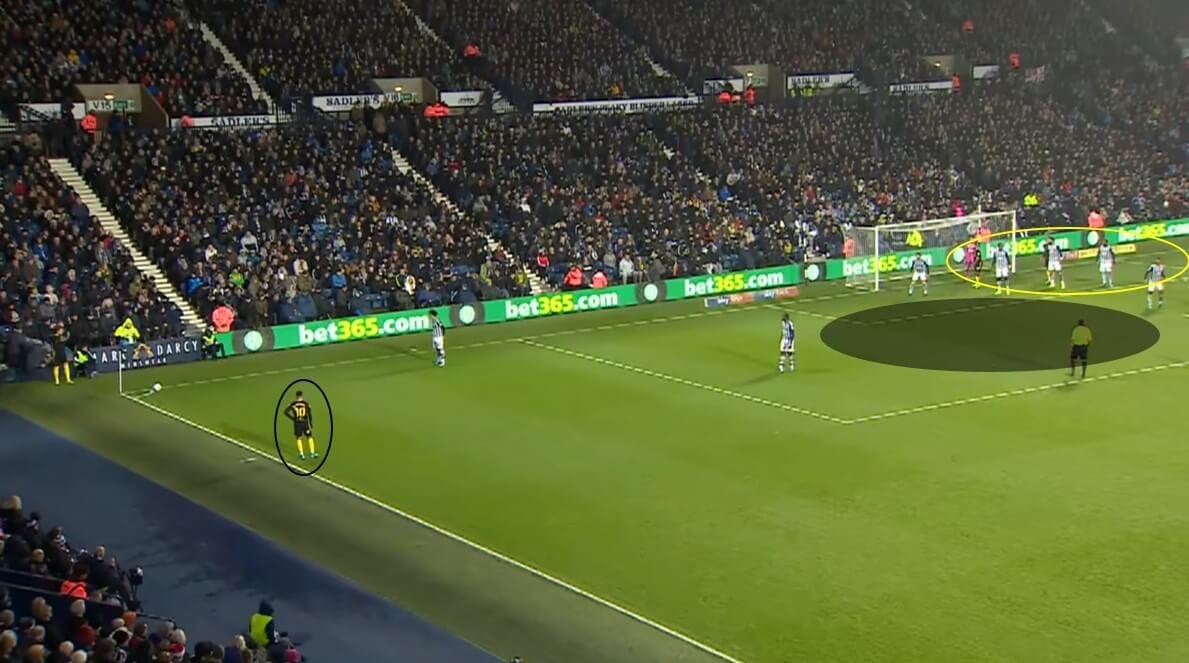
Nevertheless, Henrik Dalsgaard makes a diagonal run into the unoccupied space and scores via a glancing header.
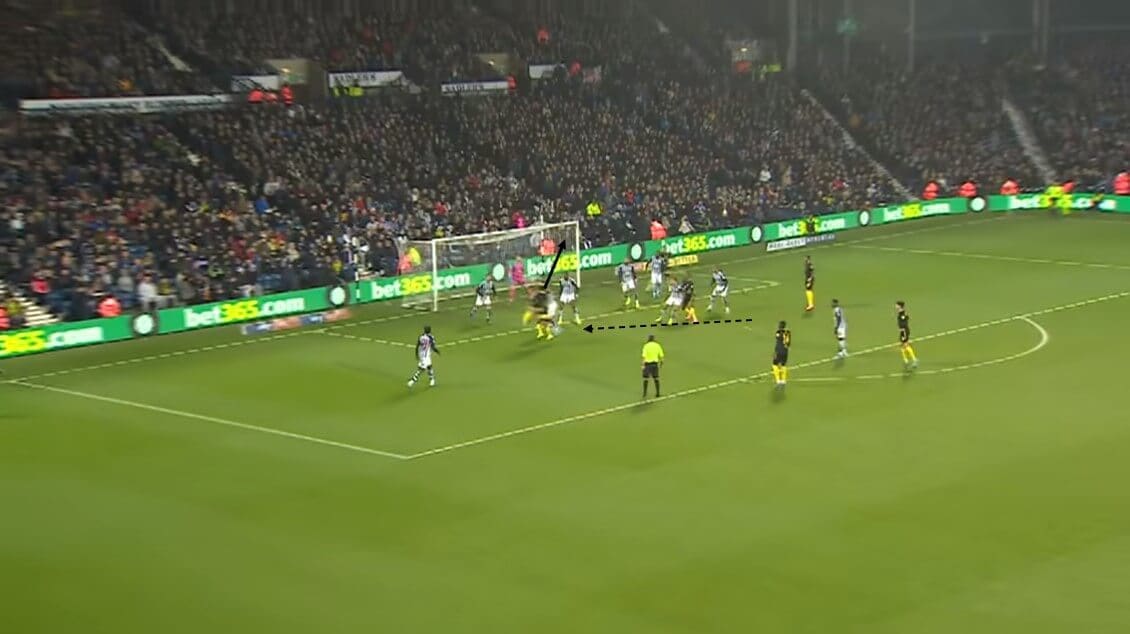
These are great examples of the offensive team taking the initiative in a set-piece situation and being rewarded.
Brentford FC Free-kick Routine
There have also been instances where their free-kick routines have been quite interesting.
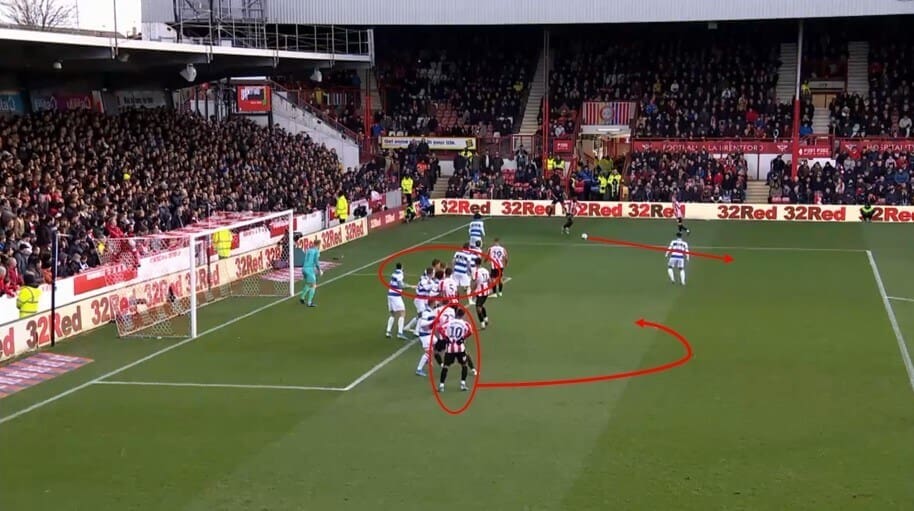
In the image above we can see how depth is being provided, with those also acting as blockers.
Dasilva begins the sequence with a dummy run over the ball.
The number 10 Benrahma curves his run to finish on the move from an unoccupied central location because of his teammates’ actions, which are vital to its success.
Conclusion
Brentford has some of the best attacking players in the EFL Championship, illustrated by their individual output this season.
The Bees have scored 64 goals in 37 games (a rate of 1.73 per game).
Set-piece situations originated 12 goals, 19% of their overall goals scored, showing their importance in football and how worthwhile having a Set-Piece coach is for Brentford.
Mbeumo and Benrahma on either flank have excellent technical ability.
Thomas Frank seeks to get the most out of his star wingers by allowing them to remain wide.
The Danish head coach knows midfielders like Dasilva and Jensen will still provide balance, as will Christian Nørgaard´s capability to feed them.






Comments